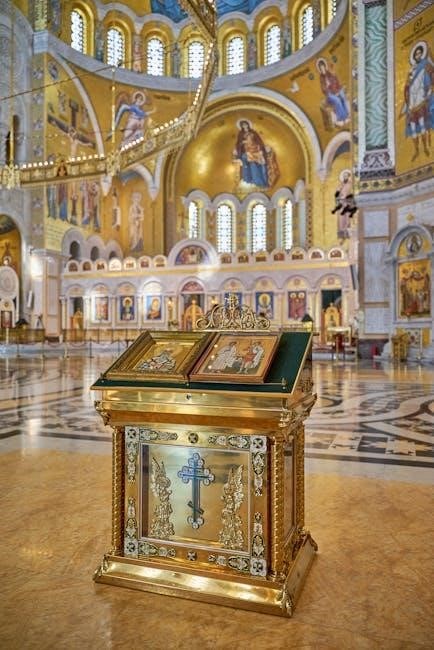The Iconostasis is a prominent feature in Orthodox churches, serving as a sacred screen adorned with icons that separates the sanctuary from the nave, embodying deep theological and artistic significance.
Overview of the Iconostasis
The Iconostasis is a distinctive feature in Orthodox churches, functioning as a decorative and symbolic screen that separates the sanctuary (altar area) from the nave (where the congregation gathers). Typically constructed of wood, stone, or metal, it is adorned with multiple tiers of icons, creating a visually rich and spiritually meaningful barrier. The central doors, known as the Holy Doors, and the side doors, or Deacons’ Doors, provide access for clergy. The Iconostasis serves both practical and symbolic purposes, offering a physical separation while also acting as a visual representation of the connection between the divine and earthly realms. Its design reflects the theological and artistic traditions of the Orthodox Church.
Importance in Orthodox Worship
The Iconostasis holds profound significance in Orthodox worship, serving as both a visual and liturgical tool. It creates a sacred barrier between the sanctuary and the nave, emphasizing the mystical nature of the Eucharist and the clergy’s role in mediating between the divine and the congregation. The icons displayed on the Iconostasis visually narrate salvation history, from Old Testament prophets to the life of Christ and His saints, educating the faithful and inspiring devotion. During services, the opening and closing of the Holy Doors symbolize the revelation and concealment of divine mysteries, while the icons themselves foster prayer and contemplation. This sacred screen is central to the spiritual experience, bridging heaven and earth in Orthodox liturgical tradition.
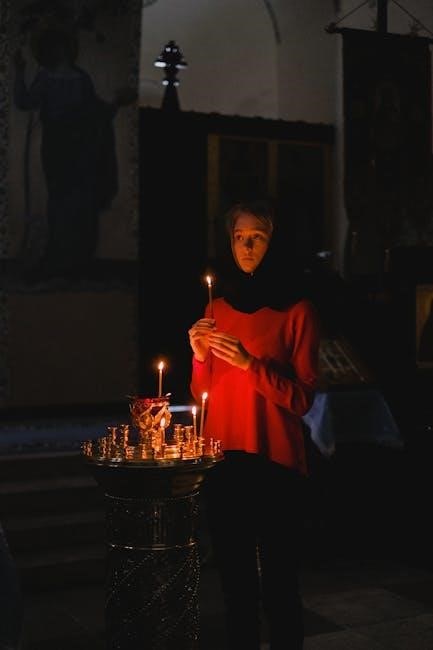
The Structure and Composition of the Iconostasis
The Iconostasis is a multi-tiered screen of icons, divided into rows, with the royal doors and deacon doors at its center. Its structure reflects Orthodox theology, blending art and symbolism.
Historical Development of the Iconostasis
The Iconostasis emerged as a low barrier in early Christian churches, gradually evolving into a multi-tiered screen adorned with icons. Its development reflects shifting theological and artistic trends. Initially, it served as a simple separator between the sanctuary and nave, but by the Byzantine era, it became a complex structure with multiple rows of icons. The Iconoclasm period influenced its design, as icons regained prominence after the controversy. Over centuries, regional styles developed, with Russian and Greek churches adopting distinct architectural and iconographic traditions. The Iconostasis became a visual narrative of salvation history and a symbol of the heavenly realm, blending liturgical function with artistic expression.
Components of the Iconostasis
The Iconostasis typically consists of multiple tiers of icons, arranged in a specific order to depict the hierarchy of salvation history; At the center are the Holy Doors, flanked by icons of the Theotokos (Virgin Mary) and St. John the Baptist, symbolizing prayer and intercession. Above these, the Deesis Row features Christ enthroned, surrounded by archangels, apostles, and saints. Additional tiers may include scenes from the life of Christ and key events in biblical history. The structure often includes side doors, known as Deacons’ Doors, adorned with images of angels or saints. This composition visually unites the divine and earthly realms, serving as a bridge between the sanctuary and the congregation.
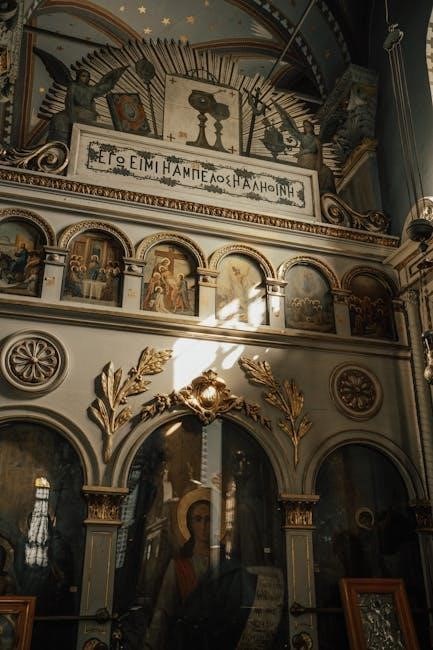
Spiritual and Theological Significance
The Iconostasis is a sacred barrier symbolizing the connection between heaven and earth, bridging the material and spiritual worlds. It embodies the Church’s theology, making the divine presence tangible through icons, serving as a focal point for prayer and worship that unites the faithful with the sacred.
Sacred Art and Symbolism
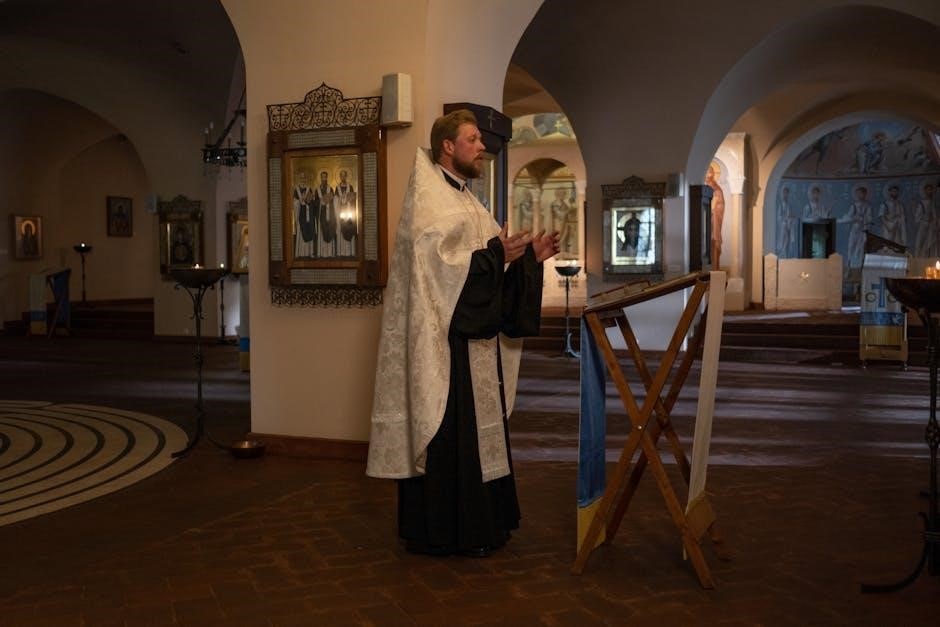
The Iconostasis is a masterpiece of sacred art, adorned with multiple tiers of icons that visually narrate salvation history. Each icon is meticulously placed to reflect theological hierarchy, with Christ, the Virgin Mary, and John the Baptist at the center, flanked by archangels, apostles, and saints. The arrangement symbolizes the unity of heaven and earth, with the Deesis Row depicting the intercession of saints; Gold backgrounds often dominate, representing divine light and the heavenly realm. The icons are not mere decorations but sacred windows into the divine, facilitating prayer and spiritual connection. Through vivid imagery and symbolism, the Iconostasis serves as a visual catechism, teaching the faithful about the mysteries of the faith and the Kingdom of God.
Separation of the Sanctuary and Nave
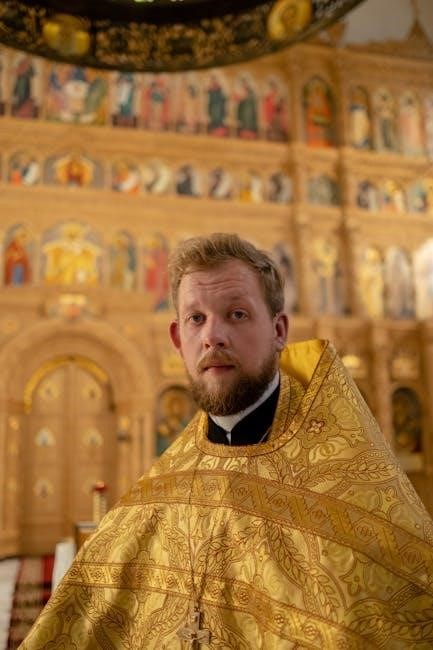
The Iconostasis serves as a physical and spiritual dividing wall between the sanctuary (reserved for clergy) and the nave (where the congregation gathers). This separation emphasizes the sacredness of the Eucharistic rites performed in the sanctuary, maintaining the mystery of the divine. The screen, often made of wood, stone, or metal, is pierced by central Holy Doors and side Deacons’ Doors, which are used during liturgical processions. While the Iconostasis visually and symbolically separates the two spaces, it also unites them through the icons and rituals that bridge the sacred and the profane, fostering a sense of reverence and participation among the faithful. This duality reflects the Orthodox understanding of the Church as both heaven and earth intertwined.
Role in Liturgical Services
The Iconostasis facilitates liturgical rituals and processions through its central Holy Doors and side Deacons’ Doors, visually connecting the sanctuary and nave during services.
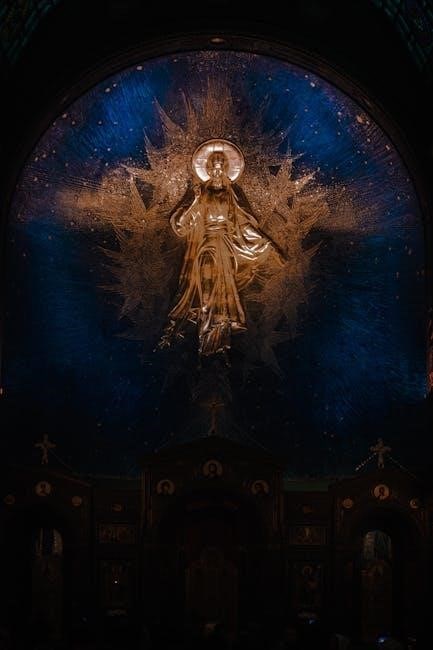
Visual Representation of Salvation History
The Iconostasis visually depicts salvation history through its tiered arrangement of icons, beginning with Old Testament prophets and Church Fathers at the base. The Deesis Row, positioned above, features Christ Pantocrator, the Virgin Mary, and John the Baptist, symbolizing intercession. The Festivals Row illustrates key events in Christ’s life, such as the Nativity, Crucifixion, and Resurrection. Higher tiers often include the Apostles and Saints, culminating in the Holy Trinity. This hierarchical structure conveys the progression of divine revelation, from creation to redemption, immersing worshippers in the narrative of salvation. The iconostasis serves as a visual catechism, enriching the liturgical experience by connecting the faithful to the divine plan.
Interaction Between Clergy and Laity
The Iconostasis facilitates a unique interaction between clergy and laity by visually and spatially connecting the sacred sanctuary to the nave. The Holy Doors and Deacons’ Doors symbolize the threshold between the divine and human realms. Clergy emerge through these doors to consecrate the Eucharist and distribute it to the faithful, while the laity remain in the nave, participating through prayer and veneration of icons. This separation emphasizes the sacred nature of the Eucharistic mystery, yet the iconostasis also serves as a visual bridge, enabling the congregation to witness key liturgical moments. The iconostasis thus fosters a dynamic interplay, balancing reverence for the sacred with communal worship.
Contemporary Design and Variations
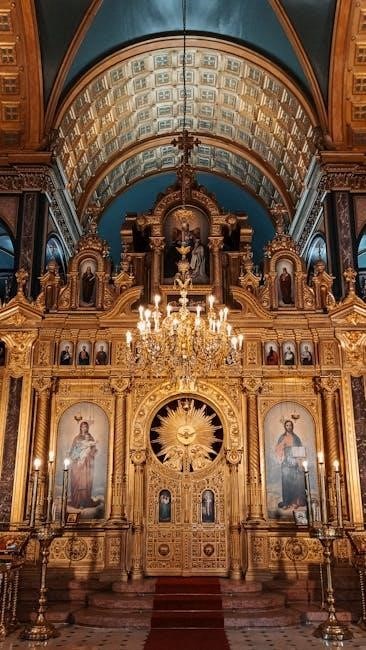
Modern iconostases blend traditional Orthodox aesthetics with contemporary materials and designs, such as glass or metal accents, while maintaining theological integrity and cultural influences in Orthodox churches.
Modern Architectural Approaches
Contemporary iconostasis designs incorporate innovative materials and styles while respecting Orthodox traditions. Architects often use glass, metal, or minimalist woodwork to create a balance between modernity and sacredness. These designs aim to maintain the theological significance of the iconostasis as a boundary between the divine and human spaces. Some modern approaches emphasize simplicity, allowing natural light to enhance the icons’ visibility, while others integrate local cultural influences, reflecting the church’s connection to its community. Despite these variations, the iconostasis remains a central element in worship, blending aesthetic innovation with spiritual continuity, ensuring its relevance in contemporary Orthodox worship spaces.
Cultural Influences on Design
The design of the iconostasis reflects diverse cultural influences, blending traditional Orthodox theology with regional artistic styles. Russian iconostases often feature intricate carvings and golden accents, while Greek designs emphasize simplicity and harmony. In Balkan churches, vibrant colors and folkloric patterns are incorporated, showcasing local craftsmanship. These variations highlight how cultural identity shapes the visual and symbolic language of the iconostasis. Additionally, modern designs may integrate contemporary artistic trends while preserving the sacredness of the tradition. This cultural diversity enriches the iconostasis, making it a unique expression of faith and heritage in each Orthodox community, while maintaining its central role in worship and spiritual life.
Notable Examples of Iconostases
The Moscow Kremlin and the Monastery of the Holy Trinity boast iconic examples, showcasing intricate designs and historical significance in Orthodox worship, reflecting both artistry and spirituality.

The Iconostasis of the Moscow Kremlin
The Iconostasis of the Moscow Kremlin is a masterpiece of Russian Orthodox art, located in the Annunciation Cathedral. It features intricate gilded carvings and masterpieces from various periods, reflecting the rich spiritual and cultural heritage of Russia. This iconic structure, with its towering tiers of icons, serves as a visual narrative of salvation history and divine presence. It is adorned with works by renowned artists, blending tradition and craftsmanship. The Kremlin’s Iconostasis stands as a symbol of Russia’s religious identity and artistic excellence, attracting pilgrims and art enthusiasts alike. Its historical significance and aesthetic grandeur make it one of the most revered examples of an Orthodox iconostasis.
The Iconostasis of the Monastery of the Holy Trinity
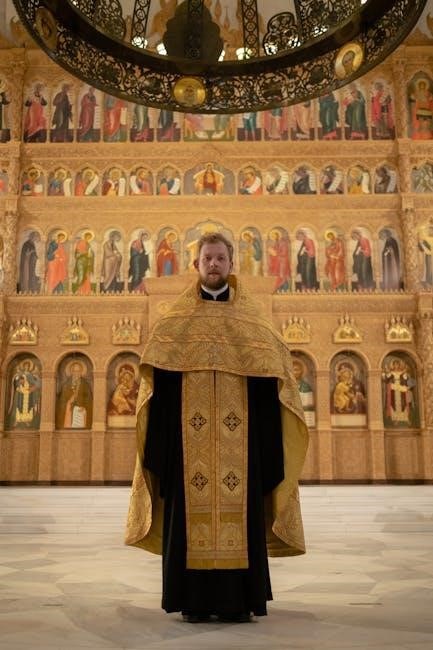
The Iconostasis of the Monastery of the Holy Trinity is a revered example of Orthodox sacred art, located near Sergiev Posad, Russia. This five-tiered iconostasis is renowned for its intricate design, blending traditional Russian architecture with spiritual symbolism. Adorned with gilded details and vibrant icons, it visually narrates the story of salvation and the glorification of God. The monastery, a cornerstone of Russian Orthodoxy, houses this masterpiece, which reflects the deep theological and cultural heritage of the faith. Pilgrims and visitors alike are drawn to its beauty and spiritual significance, making it a testament to the enduring legacy of Orthodox tradition and artistry.
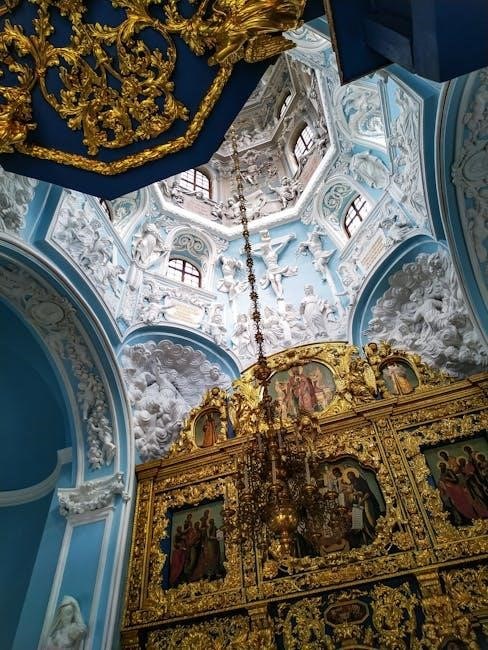
Restoration and Preservation Efforts
Restoration and preservation efforts ensure the iconostasis’s cultural and spiritual heritage are maintained, employing traditional techniques to protect these sacred artworks for future generations.
Techniques in Restoring Icons
Restoring icons on the iconostasis involves meticulous techniques to preserve their spiritual and artistic integrity. Experts carefully remove layers of old paint and varnish to reveal original details, using natural materials like egg tempera and wood. Advanced methods ensure the replication of historical painting techniques, maintaining the icon’s liturgical purpose. Specialized workshops employ skilled artisans trained in traditional practices, ensuring the restoration aligns with the theological and aesthetic principles of Orthodox tradition. The process emphasizes preserving the icon’s sacred essence while stabilizing its physical condition for future generations.
Preservation of Historical Iconostases
The preservation of historical iconostases is a critical task, ensuring the survival of these sacred structures for future generations. Specialized workshops and experts work tirelessly to restore and maintain the integrity of these iconic screens. Techniques include careful cleaning, stabilization of damaged areas, and the use of traditional materials to refurbish icons. Educational programs and community involvement also play a vital role in raising awareness about the importance of these cultural and religious treasures; Grants and donations often support these efforts, highlighting the shared responsibility in safeguarding this essential part of Orthodox heritage. Preservation ensures that the iconostasis remains a vibrant link to the faith and history it represents.
The iconostasis stands as a timeless and sacred element in Orthodox churches, bridging the divine and human realms through its rich symbolism and artistry. Its historical evolution, theological depth, and cultural significance underscore its importance in worship and tradition. From its early forms as a simple screen to the intricate, multi-tiered icon stands of today, the iconostasis reflects the faith and devotion of the Orthodox community. Preservation efforts ensure its survival, while contemporary designs continue to inspire new generations. As a visual narrative of salvation and a separator of the sacred, the iconostasis remains an enduring testament to the spiritual and artistic heritage of the Orthodox Church.
